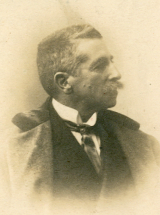U.Porto Memory
University of Porto Famous Alumni
José de Brito
 |
José de Brito 1855-1946 Painter and lecturer |
 José de Brito was born in Santa Marta de Portuzelo, Viana do Castelo, on 18 February 1855.
José de Brito was born in Santa Marta de Portuzelo, Viana do Castelo, on 18 February 1855.
In 1873, following his natural vocation, he was admitted to the Porto Academy of Fine Arts, and was taught by Tadeu de Almeida Furtado, João Correia and Soares dos Reis, among other. One of his dearest friends and colleague was Henrique Pousão, whom he worked with for the magazine "O Ocidente" and in the Porto Artistic Centre, and attended Sunday mass with at the Congregados Church.
After completing his course, he returned to his home town where he continued to paint. Using an improvised studio, he produced paintings with ethnographic themes, and was "discovered" by chance by Ramalho Ortigão, during one of his travels in Portugal. The author of "As Farpas" was thrilled by his talent and humble nature and succeeded in getting him a royal grant from King Fernando II in 1885, which enabled him to study at the Julien Academy in Paris, with Boulanger, J. Lefébre, J. P. Laurens and Benjamin Constant.
 From 1888 on, he began to take part in exhibitions held at the Parisian Salon, and received an award in 1895 for his painting Martyr du Fanatisme (Martyr of Fanaticism), a medal and public recognition. This painting would also receive the 1st medal awarded by the Grémio Artístico in 1898.
From 1888 on, he began to take part in exhibitions held at the Parisian Salon, and received an award in 1895 for his painting Martyr du Fanatisme (Martyr of Fanaticism), a medal and public recognition. This painting would also receive the 1st medal awarded by the Grémio Artístico in 1898.
In the meantime, after the death of the King Fernando II, and in recognition of his value, the Portuguese State granted him a pension, which he renounced in 1890 as he had already achieved such status that he was able to live on his artistic work alone.
In 1896, when he returned to Portugal he applied for the post of Professor of Historical Drawing at the Porto Academy of Fine Arts, with his work entitled O bom samaritano (The Good Samaritan), for which he received the first prize. He then launched his teaching career which lasted for about three decades, and was awarded Professor Emeritus status in 1929.
In 1928 he held a solo exhibition at the Salon Silva Porto, Porto.
After leaving public education, he continued to tutor private students in his studio, located in the building where the Public Municipal Library of Porto now stands.
Some of the works commissioned to José de Brito include O Baptismo de Cristo (The Baptism of Christ), for Trindade Church, the painting on the ceiling of São João Theatre, in Porto, and the Retrato de Júlio António de Amorim (Portrait of Júlio António de Amorim) for São Marcos Hospital, in Braga.
He received many awards in Portugal and abroad, namely from the National Society for Fine Art and from Grémio Artístico; a gold medal at the National Exhibition held in Rio de Janeiro, in 1908; a silver medal at the International Exhibition held in Pacific Panama; a bronze medal at the International Exhibition held in Paris, in 1900. A distinguished artist, José de Brito socialized with other intellectuals and painters, such as Eça de Queirós, Eduardo Prado, Silva Porto, Marques de Oliveira and Sousa Pinto.
He died on 26 March 1946, at the age of 91.
(Universidade Digital / Gestão de Informação, 2008)
Last updated: 2016-01-05 Webpage created on: 2025-06-16 20:12:48 Complaint Portal